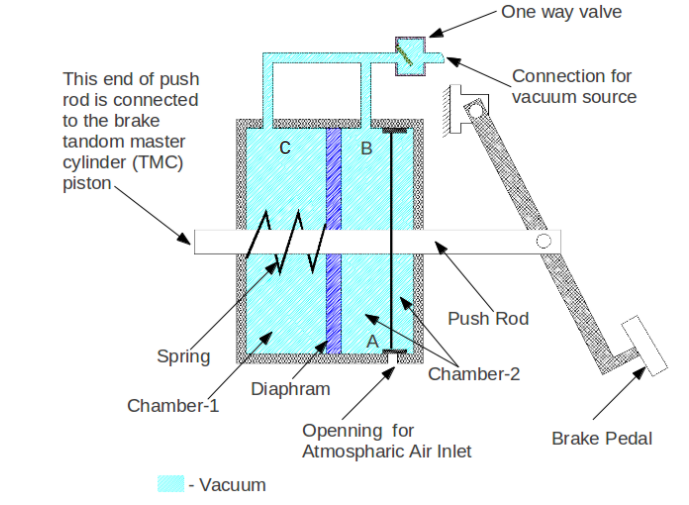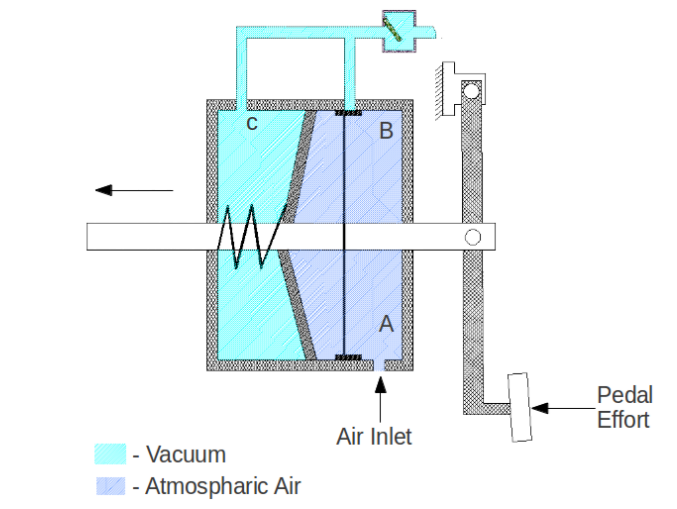What does a brake booster do?
When you press the brake pedal of your car, as you press it more, you apply more pressure through your leg, and more amount of braking applied to your car.
Brake vacuum servo booster helps increasing the braking of the car without increasing the pedal effort. In other words, some of the force required for the braking is generated in the booster itself and your leg supply the remaining. So, the effort of your foot get reduced.
Construction of it
The major functional components of a brake booster are simplified and depicted at the below picture:

As you can see, the whole chamber (shown in black dense hatching in the above picture) of the booster is divided into two sub chambers (chamber-1 and chamber-2) by means of the diaphram (shwn in blue hatching).
The centre of the diaphragm is attached with the push-rod. One end of the push rod is connected with the brake pedal and the other end is connected with tandem master cylinder (not shown in the picture).
A helical compression spring is there around the push rod in the chamber-1 to support the diaphragm.
There are total three numbers of ports A, B and C in the vacuum booster. The port A is used for getting the atmospheric air in to the chamber-2. Where as the ports B and C are used for sucking or creating vacuum at the chamber-2 and chamber-1 respectively. The ports B and C are connected to the vacuum source (engine inlet for petrol engine or vacuum pump for diesel engine).
Between the ports B and C and vacuum source, a one way valve is fitted. The purpose of this one way valve is to allow sucking air out (creating vacuum) from the vacuum booster chambers and to prevent air from coming in to the booster
How Does Brake Booster Work?
When the brake pedal is in normal (un-depressed) condition (refer above figure-1):
- The port-A is closed, so no air can come inside.
- The port-B and port-C are open, which allows creating vacuum in both the sub-chambers (B and C).
- In this condition both sides of the diaphragm remains in same amount of vacuum pressure.
When the brake pedal is in depressed condition (refer below figure -2):
- The port-A opened, which allows atmospheric air to come inside the sub
chamber-2.
- The port-B get closed, which prevents the vacuum source to suck from the sub chamber-2.
- Vacuum suction happens only from the sub chamber-1.
- The atmospheric air pressure inside the sub chamber-2 pushes the diaphragm. As a result the push rod get additional thrust to apply to the tandem master cylinder.
- Net result is that the applied force to the tandem master cylinder piston is the sum of the pedal effort force and the force developed by the atmospheric air to the diaphragm.

The one way valve plays an important role for the operation of hydrovac or hydraulic power brake booster, it preserves the vacuum in the chambers so that even in case of the engine or vacuum pump malfunction, the brake get vacuum assistance for few stroke before it become the totally driven by foot pedal effort.
Hi, I am Shibashis, a blogger by passion and an engineer by profession. I have written most of the articles for mechGuru.com. For more than a decades i am closely associated with the engineering design/manufacturing simulation technologies. I am a self taught code hobbyist, presently in love with Python (Open CV / ML / Data Science /AWS -3000+ lines, 400+ hrs. )
